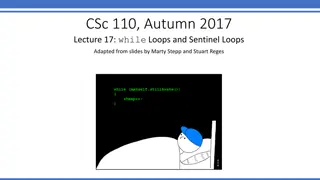Introduction to Python Programming Lab 8: Loops
This document provides a comprehensive guide on starting with Python programming by setting up the environment, creating files, and understanding loops. It covers the basics of for and while loops with examples, syntax, and objectives for exercises. Through step-by-step instructions and images, learners can easily grasp the concepts and practical implementation of loops in Python.
Download Presentation

Please find below an Image/Link to download the presentation.
The content on the website is provided AS IS for your information and personal use only. It may not be sold, licensed, or shared on other websites without obtaining consent from the author. Download presentation by click this link. If you encounter any issues during the download, it is possible that the publisher has removed the file from their server.
E N D
Presentation Transcript
Introduction to Programming Python Lab 8: Loops PythonLab8 lecture slides.ppt 1 19 November 2019 or 6 March 2020 Ping Brennan (p.brennan@bbk.ac.uk)
Getting Started Create a new folder in your disk space with the name PythonLab8 Launch the Python Integrated Development Environment (IDLE) - begin with the Start icon in the lower left corner of the screen. If you are in a DCSIS laboratory, search using the keyword Python and click on IDLE (Python 3.6 64-bit) . A window with the title Python 3.6.2 Shell should appear. This window is the Shell. 2
Getting Started (2) If you are in the ITS laboratory MAL 109, then right mouse click on the Start icon in the lower left corner of the screen. A list of menu options should appear and click on Search. Type Python in the search text box at the bottom of the pop-up window. A list of Apps should appear and select Python 3.4 IDLE(PythonGUI) A window with the title Python 3.4.3 Shell should appear. This window is the Shell. In the Shell click on File. A drop down menu will appear. Click on New File. A window with the `title` Untitled should appear. This window is the Editor. 3
Getting Started (3) In the Editor, click on File, and then in the drop down menu click on Save As . A window showing a list of folders should appear. To search any folder on the list, double click on the folder. Find the folder PythonLab8and double click on it. In the box File name at the bottom of the window 1. Type Vowels.py 2. Then click on the button Save in the lower right corner of the window. The title of the Editor should change to show the location of the file Vowels.py. 4
Objectives of the exercises set Objectives Use for statements to implement count-controlled loops that iterate over a range of integer values or the contents of any container. Syntax Example Explanation The string "Ohio" is stored in the variable stateName. The loop body is executed for each successive character of the string in stateName, starting with the first character. for variable in container: statements #loop body stateName = "Ohio" for letter in stateName: print(letter) # loop body All the statements in the block (loop body) have the same level of indentation. The variable letter takes each of the values 'O', 'h', 'i', 'o' in turn for each iteration. letter iteration Output O 1 O h i o The header ends in a colon h 2 i 3 o 4 5
Objectives of the exercises set (2) Objectives Use while statements to implement event-controlled loops. A while loop executes instructions repeatedly while a condition is true. Syntax Example Flow chart 1 while condition : statements i = 0 while i < 3 : print(i) i = i + 1 1 condition 2 3 4 2 All the statements in the block (loop body) have the same indentation. Output 0 1 2 3 4 The header ends in a colon. 1 In the example, the variable i is initialised outside the while loop (statement ) and updated in the loop body (statement ). 6 4
Objectives of the exercises set (3) The table below shows the working of the while loop example shown on page 6. i i < 3 ? Output using print(i) 0 i = i + 1 0 True 1 1 True 1 2 2 True 2 3 False end of the while loop 3 7
Program Vowels.py: Vowels Question 2: Problem statement Consider the following for loop, stateName = "Ohio" for letter in stateName : print(letter) The variable lettertakes each of the values "O", "h", "i", "o" in turn. The output of the code is O h i o 8
Program Vowels.py: Vowels (2) Problem statement (continued) i. Write a program that requests a string from the keyboard and then prints out the characters in the string in a vertical line, as in the above example. (see page 8) ii. Add to your program code to count the number of lower case vowels in the input string and then print out this number after printing out the vertical line of characters. The vowels are a, e, i, o, u. 9
Program Vowels.py: Vowels (3) Problem solving - Convert the following pseudo code into a sequence of Python statements in your program. Input 1. Read in a string and store it in a variable named s. 2. Declare a variable named n and assign a value of 0 to it. Process the input and display the output (steps 2 to 5). The variable n is used to keep a count of the number of lower case vowels (a, e, i, o, u) in the input string s. 3. Add the following for statement to print out the characters in the string s in a vertical line, as shown in the output example on page 8. for letter in s : print(letter) # loop body Indent the print statement in the block (loop body). 10
Program Vowels.py: Vowels (4) Problem solving(continued) 4. Inside the for loop, add an if statement to check if the letter is equal to an "a", "e", "i", "o", or "u" after the print statement in step 3. Align the print and if statements at the same level of indentation. If the combined Boolean expression is true, then add 1 to the current value of n. Use the if statement below to help you get started. if letter == "a" or letter == "e" or complete the combined Boolean expression by adding test conditions for the remaining vowels (i,o,u) : # True branch - if the combined expression is true Indent & write an assignment statement to add 1 to n and store the result in n. Recall n keeps a count of the number of lower case vowels. Note the indentation of the code. 5. Outside the for loop, write the code to print out the number of lower case vowels. Align the print and for statements. Provide a comment at the beginning of the program to explain the purpose of the program together with your name and the date. Save the program to the file Vowels.py and then run it. 11
Program NumberProperties.py: NumberProperties Create a new Editor for a new file called NumberProperties.py Question 3: Problem statement Write a program that reads a list of strictly positive integers from the keyboard, one at a time. Use a while loop to read these integers. The end of the input is indicated by the integer 0. Note that this 0 is a sentinel in that it marks the end of the input but does not belong to the set of integers whose properties are sought (PFE Section 4.3). The program then prints out the following numbers. i. the average value ii. the smallest of the values iii. the largest of the values iv. the inclusive range, that is one more than the difference between the smallest and the largest values. It can be assumed that the input contains at least one number other than 0. See PFE P4.5. 12
Program NumberProperties.py: NumberProperties (2) Problem statement (continued) Include a comment with each number that is printed out, for example: The average value is: If you need to check how a while loop behaves, then test the following code. nextNumber = 5 while not (nextNumber == 0) : # test for entry to the loop print(nextNumber) # in the loop do something with the data nextNumber = nextNumber-1 # get the next number All the statements in the block (loop body) have the same indentation. 13
Program NumberProperties.py: NumberProperties (3) Input Output The average value is 4.75 The smallest value is 2 The largest value is 9 The range is 8 Computations A set of positive integer numbers. 1. average = (2 + 5 + 3 + 9) / 4 2. mn = min(2, 5, 3, 9) For example, the numbers: 2 5 3 9 are typed in at the keyboard, one at a time. 3. mx = max(2, 5, 3, 9) 4. range = (mx - mn) + 1 Note: The Python built-in function max returns the largest value of the arguments; and the function min returns the smallest value of the arguments. 14
Flow chart of a while loop for the program NumberProperties.py (4) The largest and smallest of the values are stored in the variables mx and mn respectively. 15
Program NumberProperties.py: NumberProperties (5) Problem solving -Convert the following pseudo code into a sequence of Python statements in your program. 1. Read in an integer and store it in a variable named number * Input 2. Create a variable named count and initialise it with the value of 1. The variable keeps a count of the number of inputs. Process the input and display all required results (steps 2 to 5). 3. Create variables, for example, total to store the total of the inputs, mx to store the largest value and mn to store the smallest value. Set the value of each variable to be the value of the variable number initially. An example is shown below for the variable total. total = number * Assume that the first numeric value read in from the keyboard is a positive integer greater than 0. 16
Program NumberProperties.py: NumberProperties (6) Problem solving (continued) 4. Write a while loop statement to read in more integers as long as the condition, number > 0, remains true. Below is an outline of the algorithm needed to solve the problem set inside the loop. while number > 0 : # loop body # Add code below to read in a number number = read in an integer similar to step 1 # Add an if statement below to check if the number is not # equal to zero. if (condition tests if the number is not equal to zero) : # True branch of the if statement # i) add 1 to count as shown, indented below. count = count + 1 # Write more code inside the True branch to # ii) add number to total and store result in total # iii) Set mx to be the larger of the two values in # the variables mx and number using the max function. # iv) Set mn to be the smaller of the two values in # the variables mn and number using the min function. Note the indentation of the statements. 17
Program NumberProperties.py: NumberProperties (7) Problem solving (continued) 5. Outside the while loop, write additional code to find the average value and the inclusive range. Then write code to print all required results separately together with suitable messages. For example, the print statement below can be used to display the inclusive range. print("The range is ", mx mn + 1) Align the while statement and the additional code for step 5, such as print statements. Provide a comment at the beginning of the program to explain the purpose of the program together with your name and the date. Save your program to the file NumberProperties.py and then run it. 18
Supplementary Questions for Private Study The laboratory worksheet contains supplementary questions in section 4 for private study. You are encouraged to complete the supplementary questions at home, or in the laboratory if you have time after completing questions 2 to 3. 19























